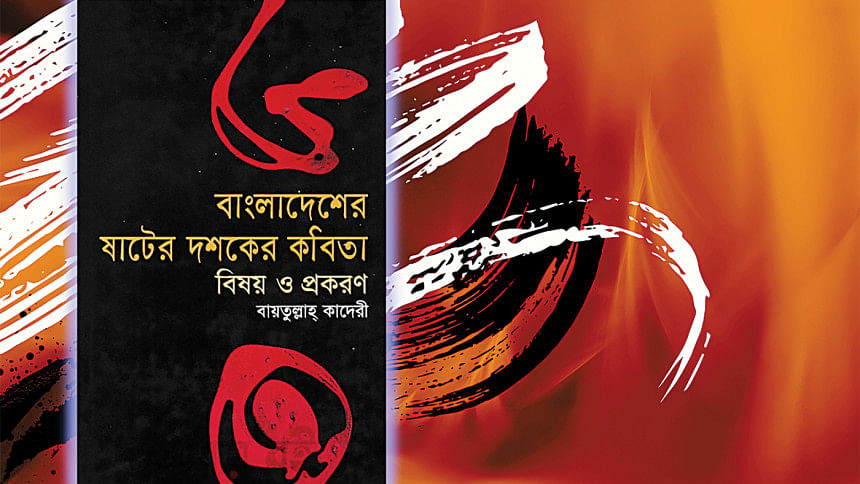Reading Baitullah Quaderee: A critic’s view of a poetic decade

When I picked up Baitullah Quaderee's Bangladesher Shater Dashaker Kabita, it wasn't particularly out of scholarly curiosity. The book is, by design, a doctoral thesis—its structure conventional, its chapters arranged by academic demand—but what caught my interest was not the format, nor even the topic. It was the author himself.
I have long paid attention to Baitullah as a poet, especially because he writes sonnets, and writes them well. In a time when free verse has become a default posture, rarely earned through prior discipline, his fidelity to meter and form is notable. Baitullah's literary sensibility, as shown in this book, is shaped by that same commitment to structure. What he offers here—perhaps without fully intending to—is a ledger of lines, a record of poets who once cared deeply about craft.
To that end, the most rewarding sections of this book are those where he compiles, excerpts, and reflects on individual lines, metaphors, and rhythms from poets of the 1960s. This is where his voice as a poet-critic quietly emerges. As Abdul Mannan Syed often said, all criticism is selection. And Baitullah, with a poet's ear and an academic's patience, has done just that.
The structure is conventional: a thesis in three parts, with historical background, thematic content, and formal analysis. But in the latter half, something else begins to take shape—a register of lines, metaphors, rhythms, and images that bear witness to a time when Bengali poetry was still deeply serious about form. This catalogue of fragments, drawn from the likes of Rafiq Azad, Abdul Mannan Syed, Mohammad Rafiq, Abul Hasan, Nirmalendu Goon, and others, is Baitullah's most valuable contribution. It is a ledger of attention.
Of course, questions of periodisation haunt any project like this. Among them, Baitullah's inclusion of Shahid Qadri as a poet of the 1960s is open to debate. Qadri, in my view, belongs more convincingly to the circle of the 1950s—not merely because of his publication history or age, but because of the poetic company he kept. In the first edition of his book Sonali Kabin (1973), Al Mahmud dedicated the book to "Shamsur Rahman, Fazal Shahabuddin, Shahid Qadri", writing in it, "may our shared-era friendship and ongoing poetic envy live on". That legendary line, widely recognised in the literary community, confirms what many have always known: Qadri stood among the younger figures of the 1950s. Stylistically, too, Qadri shared the lean, urbane, metrically resistant mode pioneered by Samar Sen—drawing from the Euro-American modernist archive without fully absorbing its formal discipline. His place in the literary history of Dhaka is important, but to call him a poet of the 1960s in the same breath as Abdul Mannan Syed or Rafiq Azad seems, to me, a misalignment—historically and poetically—despite the affectionate authority with which Mannan Syed, often imitating the stylised Old Dhaka accent, would refer to him as "ustad."
Qadri's poetry is often said to embody themes of urban alienation, loneliness, and detachment. But these themes, already explored (and exhausted) by Buddhadeva Bose and the 1930s generation, were never quite authentic in Bengali poetry. Even Rabindranath questioned their sincerity. What the 1960s inherited—through Qadri and others—was not existential angst, but a stylised echo of it.
In that sense, much of what passes as "urban modernism" in Bengali poetry of the 60s was not rooted in lived experience. It was secondhand—filtered through the literary experimentation of earlier decades and repurposed in Dhaka under the guise of innovation. That Baitullah treats these motifs with respect is understandable; that he need not regard them as historically original is also, I believe, worth saying.
If one wishes to speak of originality in the context of post-1947 East Bengali—and later Bangladeshi—poetry, one must begin with Farrukh Ahmad and Al Mahmud. Of course, Jasimuddin before them, and Nazrul even earlier, were also original in powerful ways. Jasimuddin's rural realism created an entirely new idiom, and Nazrul's revolutionary lyricism altered Bengali's rhythm forever. But both belonged to a slightly different arc—Nazrul to the Bengal of resistance, and Jasimuddin to a rural Bengal that still spoke from within undivided cultural memory.
Farrukh's Sat Shagarer Majhi (1944) must be seen as a transitional volume—standing at the cusp of the old and the new. Composed while Farrukh was studying English literature at Scottish Church College in Calcutta, alongside Subhash Mukhopadhyay, the book reincarnates, quite explicitly, the metaphysical undertow of Coleridge's Ancient Mariner—though Bengali critics have largely failed to grasp the extent of that intertextuality. The sailor who sets out across seven seas evokes not only the Arabian Nights but also the symbolist drift of Western Romanticism. And crucially, the sailor is not bound for any clear political telos—not Jinnah, not Pakistan, not even East Bengal as a nationalist project. The destination is unknown. It is this radical, almost visionary, indeterminacy that gives the poem its force. Written just three years before the Partition, the poem is haunted by a sense of uncharted destiny—a Romantic sublimity rare in Bengali verse of the time. The power of the text is amplified by its prosodic precision: composed in 'matrabritta', a meter that, as Abdul Mannan Syed noted, was beloved by both Nazrul and Farrukh. Though Farrukh did not possess deep training in Arabic or Persian, he deployed those linguistic reservoirs with exceptional rhythmic judgment—never ornamental, always musical.
This is an excerpt. Read the entire article on The Daily Star and Star Books and Literature's websites.
Dr Salahuddin Ayub, Professor and Chair, Department of Criminal Justice, Philosophy, and Political Science at Chicago State University, is the author of several books including Farashi Tattwa: Paul de Man o Shahityer Ogastyayatra (Bangla Academy, 2018). Email: [email protected].

 For all latest news, follow The Daily Star's Google News channel.
For all latest news, follow The Daily Star's Google News channel. 



Comments